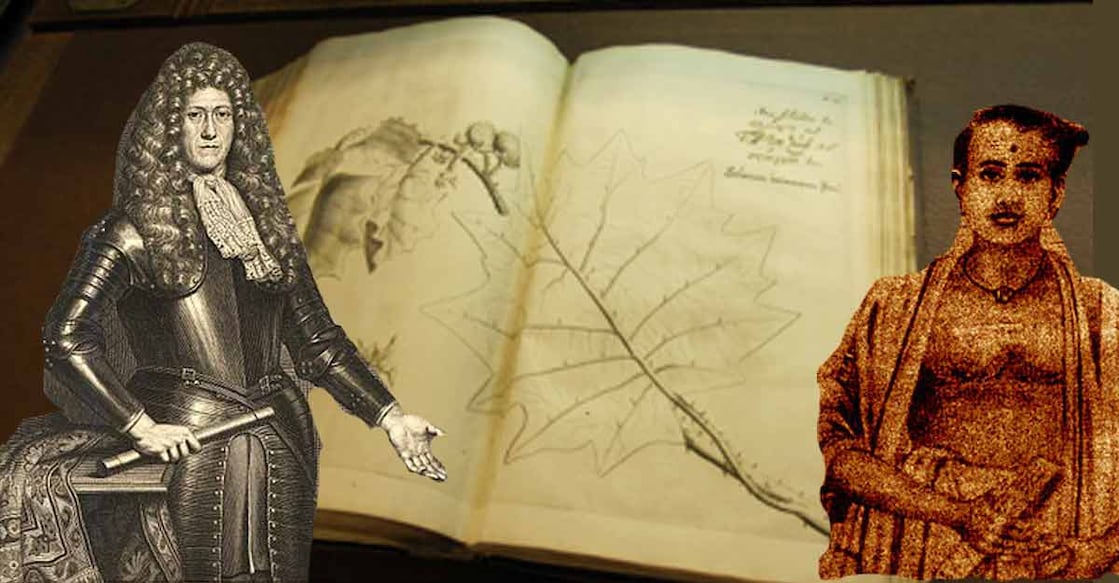Column | When a Dutch-Malayali effort helped create a great botanical treatise

Mail This Article
When one thinks of Dutch settlements and their legacy in Kerala, the first things that come to mind are the unique and grand buildings in and around Kochi, such as the Bolgatty Palace. Some old houses and buildings in Fort Kochi also have traces of Dutch architectural styles, but the influence from the Netherlands has just blended in to the melting pot. Kerala, though, is bound to Holland by a magnificent and comprehensive botanical treatise that was published in the late-17th century in Amsterdam - Hortus Malabaricus.
Garden of Malabar
Written in Latin, Hortus Malabaricus literally means Garden of Malabar. The treatise was the brainchild of Hendrik Van Rheede, who was the governor of Dutch Malabar in the 1670s. Born to a noble family in Utrecht in 1636 as Hendrik Adriaan van Rheede tot Drakestein, Van Rheede joined the Dutch East India Company as a soldier at the age of 20. He would get promoted up the ranks and eventually became the governor of Dutch Malabar.
At that time Dutch administrators were encouraged to contribute to the flourishing study of botanical science in the Netherlands. “Not only professional botanists, professors of botany and directors of botanical gardens, but also amateurs, soldier and sailors, surgeons, chemists, physicians, merchants, administrators, politicians and even the stadtholders (chief magistrates) of the Dutch Republic were engaged in collecting growing, distributing and classifying plants,” J Heniger wrote in his book titled Hendrik Adriaan van Rheede tot Drakenstein (1636-1691) and Hortus Malabaricus: A Contribution to the History of Dutch Colonial Botany.
With his deep interest in the flora of Kerala and the entire west coast of India, including the Western Ghats, Van Rheede decided to compile an encyclopedia set of the plants and flowers of the region.
It would have been impossible for the Dutch official to compile the treatise without the help of local experts, and for this he was connected to Itty Achudan, a reputed Ayurvedic physician from the Kolatt family, by the then ruler of Kochi. Tasked with writing the treatise, Achudan worked with Appu Bhat, Vinayaka Pandit and Ranga Bhat, scholars of Konkani origin.
Achudan referred to palm-leaf manuscripts for information about the medicinal and other properties of the plants. The Konkani scholars verified the information with a textbook written in Konkani in the Devanagari script.
Achudan dictated the work in Malayalam before it was translated into Latin. Hortis Malabaricus, which was then further compiled by Van Rheede, comprises 12 volumes of up to 500 pages each. The illustrations in the treatise were mainly drawn by the Discalced Carmelite Mathaeus of St. Joseph’s Monastery at Varapuzha, with contributions from Dutch technicians, illustrators and engravers.

Other contributors to the text of Hortus Malabaricus included Theodore Jansson of Almeloveen, a Dutch physician and editor of classical and medical works, Joannes Commelinus, a Dutch professor of botany and Paul Hermann, a German botanist.
The first volume was published in 1678, while the last was out in 1693, two years after Van Rheede’s death.
“Hortus Malabaricus has become famous for various reasons in the history of botany,” J Heniger wrote. “In the first place, it’s a climax in 17th century botanical literature because of its ample size of 12 folio volumes, its detailed description of plants and its magnificently produced engravings in double folio size. In addition Hortus Malabaricus became known for the fascinating account of its genesis, which Van Rheede has himself described in the third volume.” The treatise was one of the main sources for Swedish botanist Carl Linnaeus (who formalised binomial nomenclature, the modern system of naming organisms) for his knowledge of the tropical vegetation of Asia.
Malayalam and English translations

Hortus Malabaricus has been celebrated since its publication in Holland, but Achudan’s original Malayalam was never preserved, leading it to be largely forgotten in Kerala, the origin of the treatise. It would take the sheer passion, dedication and hard work of Professor Kattungal Subramaniam (K S) Manilal for the treatise to be available in Malayalam and English.
Manilal, a botanist and taxonomist, and Emeritus Professor at the Calicut University first came across Hortus Malabaricus in his father’s clippings in the 1950s. He would dedicate his life to translating the treatise into English and Malayalam. For this he had to track down each of the 742 plants mentioned in the treatise to the same areas from where they were collected in the 17th century. Since modern taxonomic classification changed since the time of Achudan and Van Rheede, the plants had to be identified anew.
His monumental efforts were finally recognised by the Government of India in 2020 and the 82-year old taxonomist was awarded the Padma Shri award under the science and engineering discipline.
Thanks to Professor Manilal, Hortus Malabaricus, a testament to the love of nature that is an integral part of both Dutch and Malayali culture, is easily accessible to the general public.
(Ajay Kamalakaran is the author of ‘A Week in the Life of Svitlana’ and ‘Globetrotting for Love and Other Stories from Sakhalin Island')


